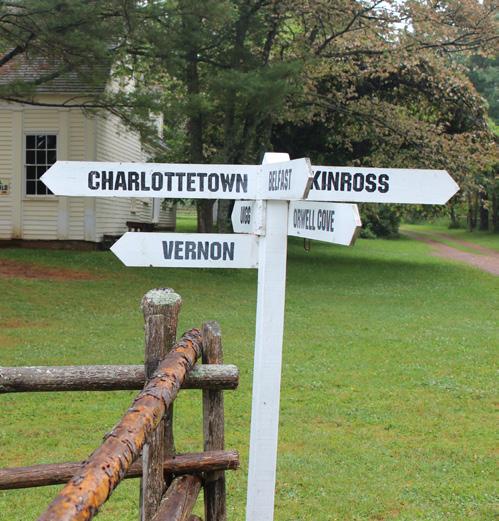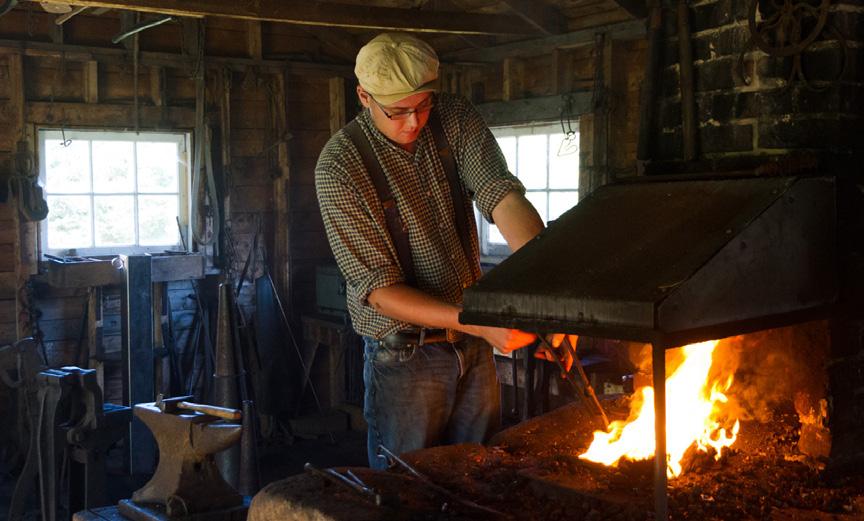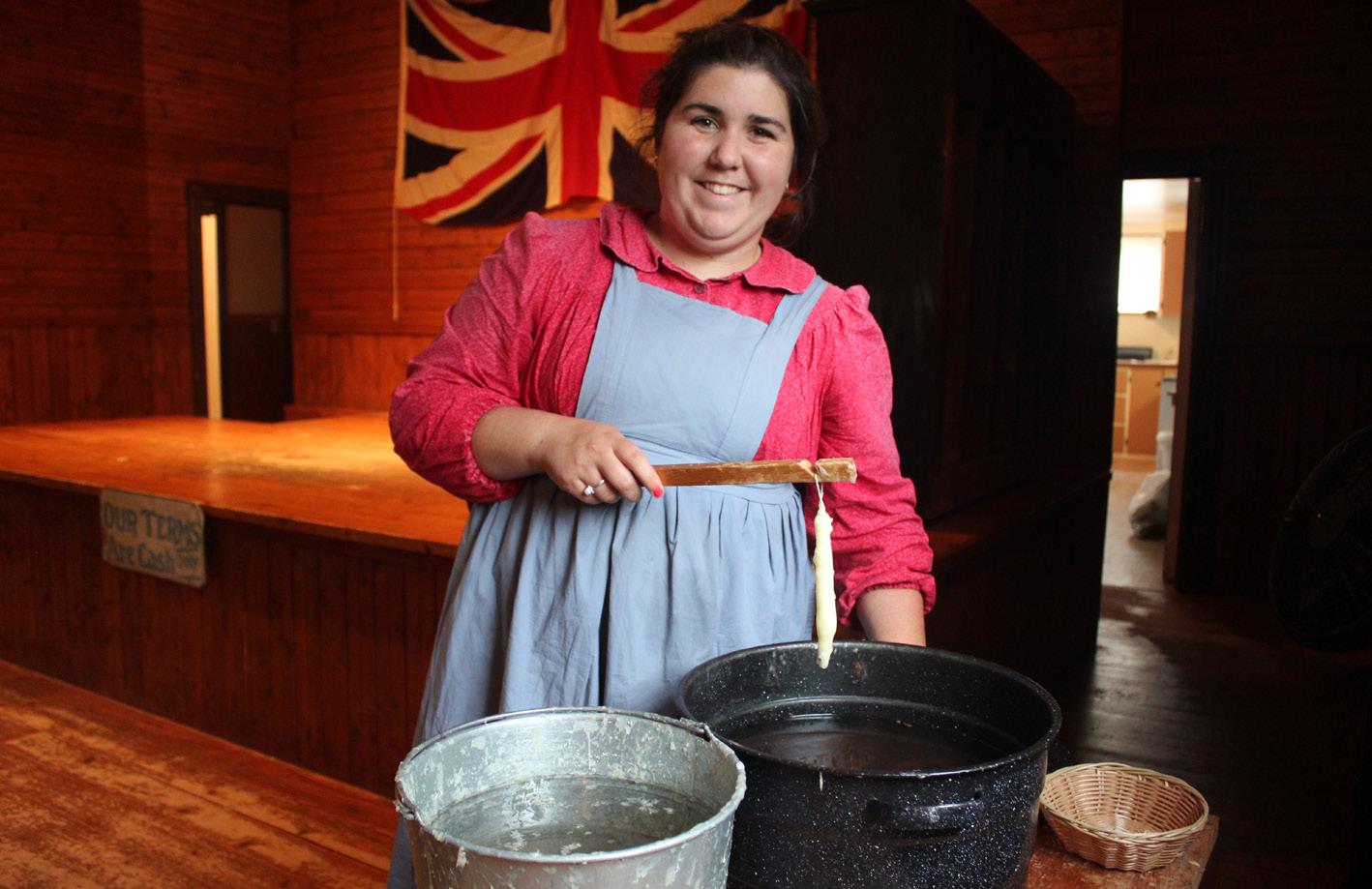
5 minute read
Dig your hands into history
A visit to Orwell Corner Historic Village
BY DARCY RHYNO
Ilike a museum where I can get my hands dirty. I want to feel in my muscles and bones what it was like to live daily life back when almost everything was handmade. I want to work a piece of wood, ride a horse, dip a beeswax candle, churn butter and cook over the hearth. That’s why Orwell Corner Historic Village in rural PEI is one of my all time favourites.
Right now, I’m getting my hands dirty in the blacksmith shop, hammering at a red hot length of metal, shaping it on the anvil into a square nail. The coal fire in the forge is blazing hot inside the otherwise dimly lit shop. Nails like the one I’m making are probably holding this shop together—and most of the buildings in the village. I learn from the blacksmith that shoes for the horses are made here, as are hinges for the doors, hooks for coats, machine parts, tools and kitchen utensils. I have a new appreciation for craftsmen so skilled, they sometimes doubled as the village dentist.
The Orwell blacksmith shows me how to add coal to the forge and work the bellows, puffing the smoking heap into a blazing inferno that lights up the shop as if the sun just shone through an open window. I hold my stick of metal in the fire, pull it out and place it on the anvil. As I work it with the hammer, it fades from white, to yellow, orange and red, and finally to grey.
In the end, it’s questionable whether or not a carpenter could pound the crooked thing into a board without bending it, but I’m happy to head off to the next Orwell Village experience with my prize and a pair of dirty hands.
Daily life in the 1890s
Orwell Corner Historic Village re-creates daily village life on the island in the late Victorian period, the 1890s. The village was founded by 19th century settlers from the British Isles. Captain John MacDonald arrived with some. Others emigrated from the Isle of Skye in Scotland and County Monaghan in Ireland. Still others were United Empire Loyalists from the American Eastern Seaboard. Even today, many residents of the Orwell area are descendents of these earliest settler families.
Orwell Corner is about 30 kilometres from Charlottetown, and thrived as an eastern island agricultural crossroads. There’s a school in the village—I had a short


TOURISM PRINCE EDWARD ISLAND DARCY RHYNO

DARCY RHYNO
Orwell Corner Historic Village
Location Orwell Corner Historic Village is located just off the Trans Canada Highway, Route #1 midway between Charlottetown (28 kms or 20 minutes) and the Northumberland Ferries Terminal at Wood Islands (32 kms or 25 minutes). Hours of Operation July and August Daily 8:30 am to 4:30 pm
June, September and October Weekdays 8:30 am to 4:30 pm
Admission Adults: $9.95 Student (6 to 8 years old) : $5.50 Five and under: free Seniors: $9.05 Family (2 adults, 2 kids): $26.00
Contact Information Phone: 902-651-8515 Website: orwellcornervillage.ca
Make a candle, take a turn at the forge, enjoy a meal and meander the grounds at Orwell Corner Historic Village.
lesson earlier—a shingle mill, a church and the Clarke Store where I pretended to shop for items such as skates for my boots and toys for the kids. I found a beautiful painted metal horse with moving legs pulling a cart with working wheels.
At the village hall, I dip a beeswax candle and learn how to keep it straight and even. Making candles is also part of an experience called The Acadian Connections that includes stories of Alexis Doiron and his family, Acadians deported from this area in 1758 as part of the British expulsion of French settlers. This experience includes farm activities such as grooming one of the handsome le Cheval Canadien horses.
The hall doubles as Anna’s Tea Room, so when I finish my candle, I order the soup of the day with homemade biscuit, a cup of tea and some ginger cookies. While I wait for my lunch, I check out the display of period parlour games like “How Silas Popped the Question,” marbles, and liars dice—instead of numbers, the white cubes are marked with playing cards from the nine up to the ace.
On the hall’s hardwood stage, Orwell Corner presents weekly performances of traditional music. The Hey Fiddle Fiddle experience is hosted here, as well. Visitors get to try the fiddle and learn a few traditional dance steps to Celtic music of the time. Some sign up for 1895 date nights called Courting at the Corner. Participants learn the finer points of period etiquette and are treated to a traditional dinner. The Victorian Harvest Feast takes place here every autumn. Guests tuck into a plateful of Irish boiled dinner with potatoes, cabbage and parsnips grown in the fields plowed by horses. Flour ground by hand is used to make bannock as a side for the meal.
Perhaps the most complete hands-on experience at Orwell Corner is called Bread and Butter. It starts with harvesting grain from the fields using a scythe. With a bushel of grain in hand, visitors grind it into flour before heading off to the barn to milk the goats. With the milk and flour ready, it’s time to learn the art of making a Scottish sourdough loaf and to churn some butter. It’s hard to imagine anything more satisfying that biting into a slice of fresh bread made from grain you harvested yourself, dripping with butter you churned by hand.
After lunch, I head outside, looking for one last hand-dirtying experience. It’s easily found among the farm animals at the barn, in the pens and about the yard. There are goats and chickens to feed, eggs to collect, horses to groom and pigs to scratch. Orwell Corner is a mixed farm in the traditional sense because it relies on the closed loop of animal and crop farming. Manure from the barns is spread on the fields. Wool from sheep in the pasture gets made into clothing. Milk and eggs supply the kitchen.
In May and June, Orwell’s most popular experience for kids takes place: New Life on the Farm. It’s when that cycle of life is most evident. There are lambs to bottle feed and chicks to water. Young turkeys, geese, pigs and cows run about like the children themselves, everyone from the goslings to the grade schoolers happily dirtying their hands and their feet.










